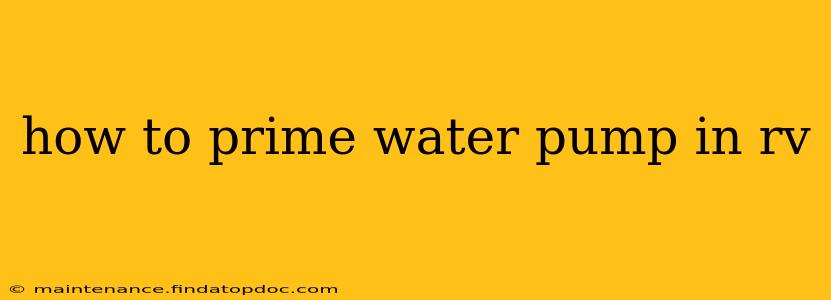RVing offers unparalleled freedom, but a malfunctioning water pump can quickly dampen the experience. Knowing how to prime your RV's water pump is a crucial skill for every RVer. This guide will walk you through the process, addressing common issues and helping you get back to enjoying your travels.
Why Does My RV Water Pump Need Priming?
Your RV water pump needs priming when it loses its suction, meaning air has entered the lines. This prevents the pump from drawing water from your freshwater tank. Several factors can cause this, including:
- Low water levels: Running the pump with a near-empty tank can introduce air.
- Leaks: Leaks in the water lines can lead to air entering the system.
- Winterization: After winterizing, air can remain in the lines.
- System maintenance: Working on the water system can accidentally introduce air.
How to Prime Your RV Water Pump: A Simple Method
The simplest method involves a few key steps:
-
Check the Water Level: Ensure your freshwater tank has sufficient water. A low tank can be the culprit, leading to repeated priming needs.
-
Locate the City Water Inlet: Turn off the water pump switch. Connect to a city water supply, if available. This will often help to purge the air from the system.
-
Open Faucets: Turn on all your faucets (hot and cold). This allows air to escape more efficiently.
-
Turn on the Water Pump: With all faucets open and the city water connected (if possible), turn on your water pump switch. Let it run for a minute or two.
-
Check for Water Flow: After a short period, check if water flows from all faucets. If water is flowing, you've successfully primed the pump! Turn off the faucets.
What if the Simple Method Doesn't Work?
If the simple method fails, don't panic. Here are some troubleshooting steps:
1. Check for Leaks: Inspect all water lines and connections for any leaks. Small leaks can significantly affect the pump's ability to maintain suction.
2. Bleed Air from Individual Faucets: If water is still not flowing, try bleeding air from each faucet individually. Open each faucet completely and let the water run until a steady stream emerges, with no more gurgling sounds.
3. Check the Water Pump Itself: Make sure the water pump is securely mounted and that there's no visible damage. If it sounds unusual or is making unusual noises, you may have a more serious pump issue.
4. Examine the Water Pump's Filter: A clogged water pump filter can significantly impede water flow and require priming frequently. Check your owner's manual for filter location and cleaning instructions.
Why is My RV Water Pump Running but No Water is Coming Out?
This issue is different from a priming problem. If your pump runs but no water comes out, the problem isn't air in the lines, but more likely a blockage or pump failure. Check for the following:
- Clogged filter: As mentioned, a clogged filter is a common culprit.
- Frozen pipes: In freezing temperatures, pipes can freeze and block water flow.
- Failed pump: Unfortunately, the pump itself may have failed and require repair or replacement.
How Often Should I Prime My RV Water Pump?
You shouldn't need to prime your water pump frequently. Regular priming is usually a sign of a larger issue, such as a leak or a faulty pump. If you find yourself priming frequently, investigate potential problems.
Can I use a different method to prime my RV water pump?
Some RVers recommend using a "gravity feed" method, filling the water lines by hand using a hose, and then switching on the pump. This can help purge the air from the system. However, it is usually more time consuming and may not be necessary in most cases.
By following these steps and troubleshooting tips, you can effectively prime your RV's water pump and ensure a smooth and enjoyable camping experience. Remember to always consult your RV's owner's manual for specific instructions related to your model.
